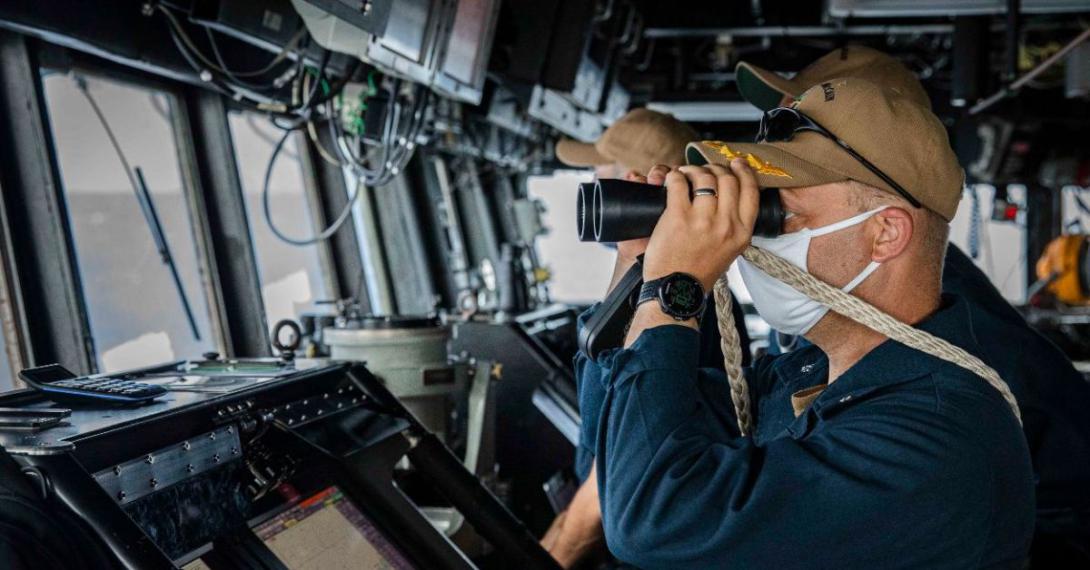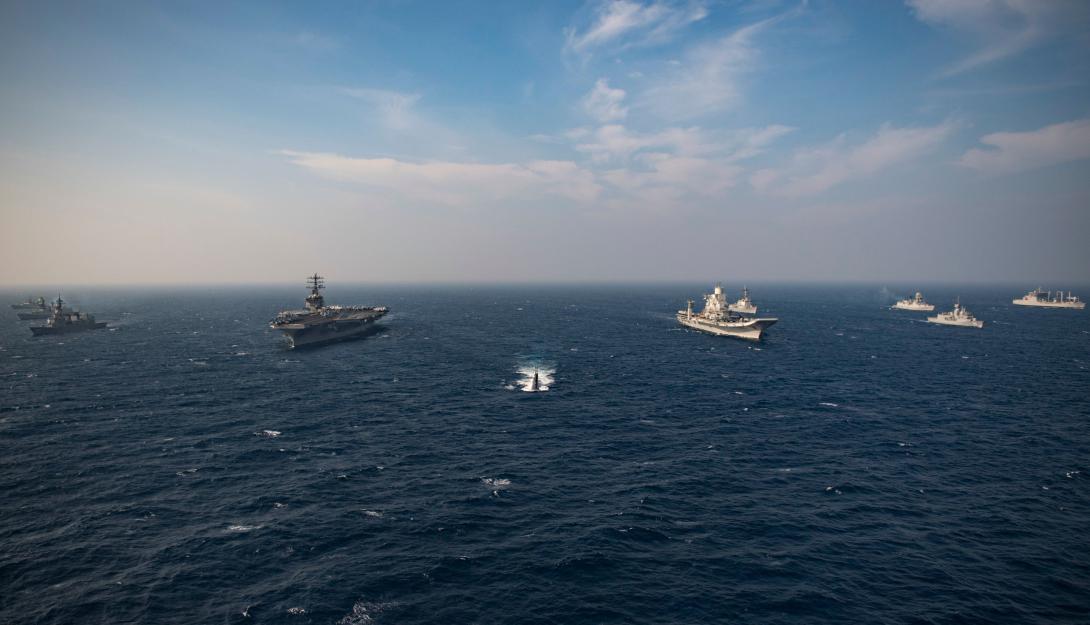U.S. INDOPACOM Charts New Operations
The push toward multidomain operations is geared toward meeting the multifaceted threat U.S. forces face worldwide, but its effects already are being felt in the Indo-Pacific region. Three nation-state adversaries, each with its own flavor of threat, are influencing U.S. efforts in that vast region to maintain peace and security.
The U.S. Indo-Pacific Command (INDOPACOM), long a guarantor of free movement across the broad hemisphere that defines the region, is working to implement changes across the force while continuing ongoing operations. Its task is complicated by the need for interoperability among the services as well as with the burgeoning list of allies and partners joining U.S. efforts to counter hegemonistic threats in the region. And, a wish list of several vital technologies may hold the key to operational success.
A free and open Pacific lies at the heart of INDOPACOM’s mission, says Rear Adm. John Wade, USN, director for operations, J-3, at INDOPACOM. This is built around a deterrence-based operational framework. “The entire region is in a competition, and the goal here is to prevent a conflict,” he declares.
The admiral cited a need to converge capabilities from multiple domains to “create the virtue of mass without the vulnerability of concentration.” This must be accomplished rapidly and at long distances while also being able to wage an effective defense. All-domain operations will require forces distributed across a large battlespace, and this mandates interoperability as well as synchronization. Many experiments underway, such as the Navy’s Distributed Maritime Operations concept, are looking at changes in organizational structures in addition to operational activities such as sensing and shooting.
Achieving these goals will require investments in several areas to ensure both deterrence and combat capability. The top area Adm. Wade cites is integrated air-missile defense. This will involve multiple sensors and interceptors distributed around the region for protection of U.S. territories as well as forward operating forces, he notes. And, it includes protection of allies and partners. This is vital in part because adversaries increasingly are turning to hypersonic air vehicles to attack U.S. assets over long distances.
The second combat capability priority is long-range precision strike. This would come from all platforms in all services for all domains, the admiral emphasizes. “You have to be able to hold a bunch of target sets at risk from a distance so that you have that right deterrent effect,” he says.
Tying these together is the third area: joint command and control (C2) networks. Having good sensors is useful only if that data can be shared so that a potential adversary can be found, fixed and targeted, the admiral offers. A joint C2 network must have speed, flexibility and proper security against cyberthreats, he adds.
The fourth area, which the admiral says represents a need that will continue to grow, is artificial intelligence (AI) and machine learning (ML). Unlike direct operational capabilities, AI and ML will be embedded in different systems and affect many operations. Benefits include increased computing power and big data analytics, which are required to support operations and ensure interoperability and compatibility for rapid decision making.
Among the problems plaguing the region, North Korea represents the most immediate threat, especially with its nuclear capability, Adm. Wade offers. Close behind is China, and the admiral states that the Middle Kingdom represents the greatest long-term strategic threat to the United States. China’s coercion and fear-stoking run counter to U.S. efforts at maintaining a rule-based international order.
Russia is another concern as it seeks to undermine U.S. interests and “impose additional costs” for the United States and its allies, Adm. Wade says. Terrorists and other nonstate actors pose a threat to an open and free Pacific. And, the last threat comes from an entirely different category: natural disasters. The Ring of Fire that encircles the Pacific causes many devastating earthquakes and volcanoes that frequently plague the region, and the COVID-19 pandemic has added its own degree of peril to the mix.
“Combined, these challenges represent the rubric by which … we do each and every day,” he says.
The region’s geographic breakdown is one discriminator for each threat. North Korea constitutes more of a localized threat, while China and Russia are more expansive, Adm. Wade points out. And, the threat exists beyond the physical domain into cyberspace and outer space.
The first area on which INDOPACOM is focused is joint force lethality, the admiral offers. This ensures that the command has the right capabilities to deter aggression and, if necessary, prevail in a conflict. With this joint force lethality comes design and posture, which entails capabilities, areas of operation and ways of employment. Being able to integrate and synchronize all these operations is key, he points out.
The third area encompasses strengthening allies and partners to ensure interoperability, information sharing and coordination to extend access across the region, Adm. Wade states. Exercises, experimentation and innovation constitute a continuous joint process for improvement in this area.
“Interoperability with allies and partners is not just communicating on UHF radio and saying that we’re good,” the admiral states. “It is—no kidding—being able to share sensor data and then to be able to coordinate effects if required. And that takes a system-of-systems approach.” This includes planning, operating together, working through configuration variances and the tactics, techniques and procedures (TTPs) related to these aspects. “Our goal is to strengthen every one of them so that we can work together immediately,” he says.
And industry has a role to play in this. Reducing configuration variance is a top goal for industry, Adm. Wade says. This entails ensuring compatibility across all systems, especially for sharing data rapidly and securely.
He notes that a recent cooperative deployment in the South China Sea that featured the United States, Japan and Australia demonstrated this interoperability capability. The three countries were able to “plug and play” and conduct operations together because they had operated jointly before under familiar TTPs and communications plans. They had the ability to integrate right away, he observes.
But when issues emerge, the command works to ensure the other country’s laboratories and systems commands can address incompatibilities and evolve their own systems. Some of these issues are worked through the Defense Department’s international connections.
Interoperability is an issue among the U.S. services as well. Being able to share information from sensors and network that data to enhance fires is not a cut-and-dried task, especially because many systems were built independently and without interoperability in mind, the admiral allows.
Meeting these challenges requires two approaches: short-term and long-term. For near-term interoperability, planning is the key. “You have to have an understanding of the environment; you have to have an understanding of what systems you have … it all comes into play,” Adm. Wade says. “So, operational planning is critical for today,” especially with the command conducting operations around the clock.
But looking ahead to the future and ensuring effective deterrence, the emphasis shifts to experimentation and innovation, he says. “We have to bring in experiments to our major exercises so we can look at what went well and then look at what didn’t.” This includes looking at the lessons from applying a sensor that is longer range or a system that provides more distant fires, he adds. Incorporating these results into operations might require organizational changes and new requirements given to laboratories.
For the near term, the biggest changes in INDOPACOM operations are arising from the COVID-19 pandemic, Adm. Wade says. “We have to continue to operate in a COVID environment. We’ve learned a lot, and we’ve done an exceptional job,” he states. This includes working with partner nations also affected by the pandemic, and the command is learning from this experience. It hasn’t stopped its exercises with partners, but it has scaled them back.
As the pandemic wanes, the command will ramp up its exercises with other nations, which is critical for its strategy, the admiral allows. Several exercises planned for this summer are important for experimentation, especially for joint all-domain operations.
The pandemic has opened doors that may allow warfighters to train better. Defense developments are happening so rapidly that personnel will need to do more self-study, the admiral posits. “We have to lead through rapid change. If we understand and set the context and let them know how the environment is going to continuously change, then they’re more apt to accept it rather than to fight it,” he adds.
COVID has actually enhanced the command’s ability to plan, the admiral suggests. “It was unexpected, and forced a team-of-teams approach to look at the issues, what we need to do to mitigate risk, and how it’s important to continue to operate,” he states. “On top of that, it forced us to ensure that we maintained our readiness to do our mission, both in the short and the long term. So, I think our capabilities to plan and work together and to innovate have been stimulated, and we’re going to be better for it in the long term.”
Ultimately, the pandemic will fade away. “Things are going to change for the better,” he declares.






Comments